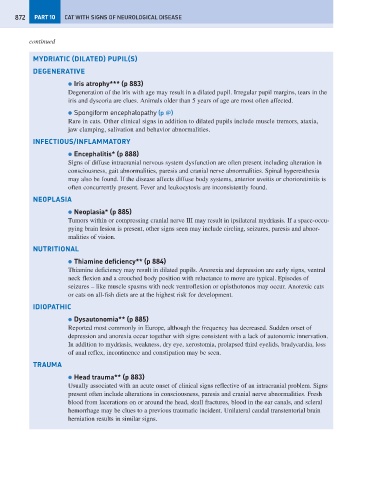Page 880 - Problem-Based Feline Medicine
P. 880
872 PART 10 CAT WITH SIGNS OF NEUROLOGICAL DISEASE
continued
MYDRIATIC (DILATED) PUPIL(S)
DEGENERATIVE
● Iris atrophy*** (p 883)
Degeneration of the iris with age may result in a dilated pupil. Irregular pupil margins, tears in the
iris and dyscoria are clues. Animals older than 5 years of age are most often affected.
● Spongiform encephalopathy (p @)
Rare in cats. Other clinical signs in addition to dilated pupils include muscle tremors, ataxia,
jaw clamping, salivation and behavior abnormalities.
INFECTIOUS/INFLAMMATORY
● Encephalitis* (p 888)
Signs of diffuse intracranial nervous system dysfunction are often present including alteration in
consciousness, gait abnormalities, paresis and cranial nerve abnormalities. Spinal hyperesthesia
may also be found. If the disease affects diffuse body systems, anterior uveitis or chorioretinitis is
often concurrently present. Fever and leukocytosis are inconsistently found.
NEOPLASIA
● Neoplasia* (p 885)
Tumors within or compressing cranial nerve III may result in ipsilateral mydriasis. If a space-occu-
pying brain lesion is present, other signs seen may include circling, seizures, paresis and abnor-
malities of vision.
NUTRITIONAL
● Thiamine deficiency** (p 884)
Thiamine deficiency may result in dilated pupils. Anorexia and depression are early signs, ventral
neck flexion and a crouched body position with reluctance to move are typical. Episodes of
seizures – like muscle spasms with neck ventroflexion or opisthotonos may occur. Anorexic cats
or cats on all-fish diets are at the highest risk for development.
IDIOPATHIC
● Dysautonomia** (p 885)
Reported most commonly in Europe, although the frequency has decreased. Sudden onset of
depression and anorexia occur together with signs consistent with a lack of autonomic innervation.
In addition to mydriasis, weakness, dry eye, xerostomia, prolapsed third eyelids, bradycardia, loss
of anal reflex, incontinence and constipation may be seen.
TRAUMA
● Head trauma** (p 883)
Usually associated with an acute onset of clinical signs reflective of an intracranial problem. Signs
present often include alterations in consciousness, paresis and cranial nerve abnormalities. Fresh
blood from lacerations on or around the head, skull fractures, blood in the ear canals, and scleral
hemorrhage may be clues to a previous traumatic incident. Unilateral caudal transtentorial brain
herniation results in similar signs.

